Mostrar el registro sencillo del ítem
dc.contributor.author
Lafuente, María Leticia

dc.contributor.author
Díaz, Gisela

dc.contributor.author
Bravo, Rodolfo Daniel

dc.contributor.author
Ponzinibbio, Agustín

dc.date.available
2018-08-08T18:22:34Z
dc.date.issued
2016-03
dc.identifier.citation
Lafuente, María Leticia; Díaz, Gisela; Bravo, Rodolfo Daniel; Ponzinibbio, Agustín; Efficient and selective N-, S- and O-acetylation in TEAA ionic liquid as green solvent. Applications in synthetic carbohydrate chemistry; Bentham Science Publishers; Letters in Organic Chemistry; 13; 3; 3-2016; 195-200
dc.identifier.issn
1570-1786
dc.identifier.uri
http://hdl.handle.net/11336/54615
dc.description.abstract
Background: The ionic liquid triethylammonium acetate (TEAA) was found to be an efficient solvent in the acetylation of alcohols, amines, oximes and thiols to their corresponding acetyl compounds using only a 10% excess of acetic anhydride under mild conditions. Moreover TEAA is not only an inexpensive and recyclable solvent but also an anomeric selective catalyst in the per-O-acetylation of sugar moieties. Methods: Simple and effective organic synthesis protocols were provided for the selective acetylation of several substrates. The products were fully characterized by 1H and 13C NMR spectroscopy and the anomeric ratios were obtained from the 1H spectra. Results: Structurally diverse alcohols, phenols, thiols, amines, carbohydrates and oximes underwent acylation under mild conditions by this procedure to provide the corresponding acetates in excellent yields. TEAA ionic liquid is unique in its capability to act as both, solvent and high selective catalyst. As expected, the reaction proceeds with high b anomeric selectivity for sugars derivatives. Moreover, the ionic liquid was regenerated, recycled and reused for three times without apparent loss of reactivity and selectivity in all cases. Conclusions: The present procedure provides a powerful and versatile acylation method for alcohols, phenols, thiols, amines, oximes and carbohydrates. This protocol is endowed with several unique merits: selectivity, cost-efficiency, atom-economy and mild reaction conditions tolerable to acid sensitive functionalities. With these features, this method may be considered as a better alternative for the acetylation of a wide range of substrates.
dc.format
application/pdf
dc.language.iso
eng
dc.publisher
Bentham Science Publishers

dc.rights
info:eu-repo/semantics/openAccess
dc.rights.uri
https://creativecommons.org/licenses/by-nc-sa/2.5/ar/
dc.subject
Acylation
dc.subject
Carbohydrates
dc.subject
Green Chemistry
dc.subject
Triethylammonium Acetate (Teaa)
dc.subject.classification
Otras Ciencias Químicas

dc.subject.classification
Ciencias Químicas

dc.subject.classification
CIENCIAS NATURALES Y EXACTAS

dc.title
Efficient and selective N-, S- and O-acetylation in TEAA ionic liquid as green solvent. Applications in synthetic carbohydrate chemistry
dc.type
info:eu-repo/semantics/article
dc.type
info:ar-repo/semantics/artículo
dc.type
info:eu-repo/semantics/publishedVersion
dc.date.updated
2018-08-06T18:04:01Z
dc.journal.volume
13
dc.journal.number
3
dc.journal.pagination
195-200
dc.journal.pais
Estados Unidos

dc.journal.ciudad
Oak Park
dc.description.fil
Fil: Lafuente, María Leticia. Universidad Nacional de La Plata. Facultad de Ciencias Exactas. Departamento de Química. Laboratorio de Estudio de Compuestos Orgánicos; Argentina. Consejo Nacional de Investigaciones Científicas y Técnicas; Argentina
dc.description.fil
Fil: Díaz, Gisela. Universidad Nacional de La Plata. Facultad de Ciencias Exactas. Departamento de Química. Laboratorio de Estudio de Compuestos Orgánicos; Argentina. Consejo Nacional de Investigaciones Científicas y Técnicas; Argentina
dc.description.fil
Fil: Bravo, Rodolfo Daniel. Universidad Nacional de La Plata. Facultad de Ciencias Exactas. Departamento de Química. Laboratorio de Estudio de Compuestos Orgánicos; Argentina
dc.description.fil
Fil: Ponzinibbio, Agustín. Universidad Nacional de La Plata. Facultad de Ciencias Exactas. Departamento de Química. Laboratorio de Estudio de Compuestos Orgánicos; Argentina. Consejo Nacional de Investigaciones Científicas y Técnicas; Argentina
dc.journal.title
Letters in Organic Chemistry

dc.relation.alternativeid
info:eu-repo/semantics/altIdentifier/doi/http://dx.doi.org/10.2174/1570178613666160104233129
dc.relation.alternativeid
info:eu-repo/semantics/altIdentifier/url/http://www.eurekaselect.com/138291
Archivos asociados
